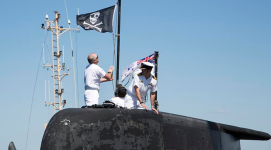The U.S. Navy has run into trouble with some of its most recently launched small ships. Built by two different major contractors, these are classified as littoral combat ships designed for coastal shallow-water duty. The Navy wants to decommission eight of ten of the current class for serious problems with propulsion systems and the lack of suitability for current needs, facing the Chinese deep water fleet rather than the small boat conflicts in the Middle East. These U.S. ships average only four years old.
Being a former enlisted minesweeper sailor aboard an Aggressive-class minesweeper in the South China Sea, a predecessor to the littoral combat ships -- and the son of a WWII YMS-class minesweeper skipper in World War II -- I've followed this new ship design closely and with great interest. I'll spare the pipe group all of the details. But it has been an interesting misstep in design and seagoing operations. The Congress doesn't want the Navy to abandon the ships, partly because of the investment already made, an partly because of the interest groups in the various states where these ships and their equipment are designed and built.
As a historical reference, the ship designing and building competition between navies goes back to the Greeks and Trojans and before. The European sea powers in the 18th and 19th Century were always jockeying between huge flagships with mighty arrays of guns to smaller, swifter and more maneuverable ships that could take shots at sinking the big ones. So this drama is not new. But it is riveting to people who've been aboard warships as crew and can sense the at-sea challenges that are, or are not met.
Being a former enlisted minesweeper sailor aboard an Aggressive-class minesweeper in the South China Sea, a predecessor to the littoral combat ships -- and the son of a WWII YMS-class minesweeper skipper in World War II -- I've followed this new ship design closely and with great interest. I'll spare the pipe group all of the details. But it has been an interesting misstep in design and seagoing operations. The Congress doesn't want the Navy to abandon the ships, partly because of the investment already made, an partly because of the interest groups in the various states where these ships and their equipment are designed and built.
As a historical reference, the ship designing and building competition between navies goes back to the Greeks and Trojans and before. The European sea powers in the 18th and 19th Century were always jockeying between huge flagships with mighty arrays of guns to smaller, swifter and more maneuverable ships that could take shots at sinking the big ones. So this drama is not new. But it is riveting to people who've been aboard warships as crew and can sense the at-sea challenges that are, or are not met.










